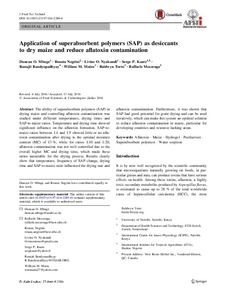| dc.contributor.author | Mbuge, D.O. |
| dc.contributor.author | Negrini, R. |
| dc.contributor.author | Nyakundi, L.O. |
| dc.contributor.author | Kuate, S.P. |
| dc.contributor.author | Bandyopadhyay, Ranajit |
| dc.contributor.author | Muiru, W.M. |
| dc.contributor.author | Torto, B. |
| dc.contributor.author | Mezzenga, R. |
| dc.date.accessioned | 2019-12-04T11:04:04Z |
| dc.date.available | 2019-12-04T11:04:04Z |
| dc.date.issued | 2016-08-24 |
| dc.identifier.citation | Mbuge, D.O., Negrini, R., Nyakundi, L.O., Kuate, S.P., Bandyopadhyay, R., Muiru, W.M., ... & Mezzenga, R. (2016). Application of superabsorbent polymers (SAP) as desiccants to dry maize and reduce aflatoxin contamination. Journal of Food Science and Technology, 1-9. |
| dc.identifier.issn | 0022-1155 |
| dc.identifier.uri | https://hdl.handle.net/20.500.12478/1331 |
| dc.description.abstract | The ability of superabsorbent polymers (SAP) in drying maize and controlling aflatoxin contamination was studied under different temperatures, drying times and SAP-to-maize ratios. Temperature and drying time showed significant influence on the aflatoxin formation. SAP-to-maize ratios between 1:1 and 1:5 showed little or no aflatoxin contamination after drying to the optimal moisture content (MC) of 13 %, while for ratios 1:10 and 1:20, aflatoxin contamination was not well controlled due to the overall higher MC and drying time, which made these ratios unsuitable for the drying process. Results clearly show that temperature, frequency of SAP change, drying time and SAP-to-maize ratio influenced the drying rate and aflatoxin contamination. Furthermore, it was shown that SAP had good potential for grain drying and can be used iteratively, which can make this system an optimal solution to reduce aflatoxin contamination in maize, particular for developing countries and resource-lacking areas. |
| dc.format.extent | 1-9 |
| dc.language.iso | en |
| dc.subject | Aflatoxins |
| dc.subject | Maize |
| dc.subject | Postharvest |
| dc.subject | Polymers |
| dc.subject | Aspergillus |
| dc.subject | Sap |
| dc.title | Application of superabsorbent polymers (SAP) as desiccants to dry maize and reduce aflatoxin contamination |
| dc.type | Journal Article |
| dc.description.version | Peer Review |
| cg.contributor.crp | Maize |
| cg.contributor.affiliation | University of Nairobi |
| cg.contributor.affiliation | Swiss Federal Institute of Technology |
| cg.contributor.affiliation | International Centre of Insect Physiology and Ecology |
| cg.contributor.affiliation | International Institute of Tropical Agriculture |
| cg.contributor.affiliation | New Roots Herbal Inc. |
| cg.coverage.region | Africa |
| cg.coverage.region | East Africa |
| cg.coverage.country | Kenya |
| cg.isijournal | ISI Journal |
| cg.authorship.types | CGIAR and developing country institute |
| cg.iitasubject | Aflatoxin |
| cg.iitasubject | Maize |
| cg.iitasubject | Post-Harvesting Technology |
| cg.journal | Journal of Food Science and Technology |
| cg.howpublished | Formally Published |
| cg.accessibilitystatus | Limited Access |
| local.dspaceid | 79255 |
| cg.targetaudience | Scientists |
| cg.identifier.doi | https://dx.doi.org/10.1007/s13197-016-2289-6 |

